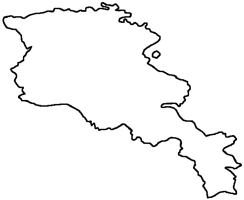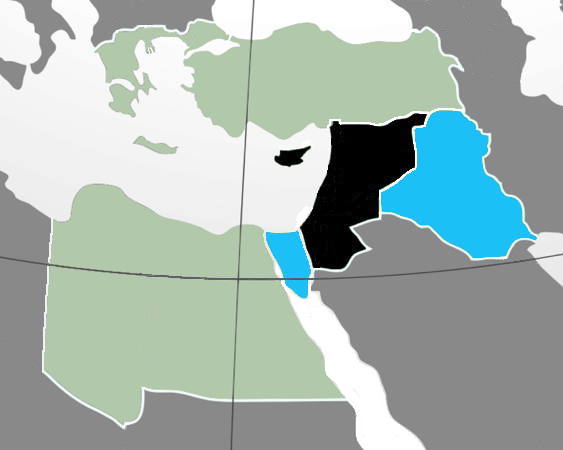
|
The Society of Folk Dance Historians (SFDH)
Armenian Dances
[ Home | About | Encyclopedia | Links | Publications | Members ] CLICK AN IMAGE TO ENLARGE |

|
BACKGROUND
 Information: Armenia was a small ancient kingdom in the Southwest Caucasus, straddling the major trade routes between Europe and Asia. Because of its strategic value, larger surrounding empires kept it divided as a buffer state. Except for brief periods of independence, the country has been continually divided into two major geographic and political divisions: Western Armenia (the Armenian plateau in what is today Eastern Turkey) and Eastern Armenia (the Armenian Caucasus). This continuous division created two distinctive culture areas, with Western Armenia sharing many features of the Levant1 and Anatolia, and Eastern Armenia sharing many traits with other people of the Caucasus and Persia. Despite these differences, Armenian culture remained coherent because of the unifying influence of the Armenian Apostolic Church.
Information: Armenia was a small ancient kingdom in the Southwest Caucasus, straddling the major trade routes between Europe and Asia. Because of its strategic value, larger surrounding empires kept it divided as a buffer state. Except for brief periods of independence, the country has been continually divided into two major geographic and political divisions: Western Armenia (the Armenian plateau in what is today Eastern Turkey) and Eastern Armenia (the Armenian Caucasus). This continuous division created two distinctive culture areas, with Western Armenia sharing many features of the Levant1 and Anatolia, and Eastern Armenia sharing many traits with other people of the Caucasus and Persia. Despite these differences, Armenian culture remained coherent because of the unifying influence of the Armenian Apostolic Church.
Armenian dance differed significantly in each area. The Western Armenian style is now extinct. The entire Armenian population was exterminated by the Turkish government during World War I. This style can still be seen in attenuated form among some expatriate Armenian communities in the United States. As might be expected, the Western Armenian style resembles the dances of the Turks and Kurds now living on the Armenian plateau. In general, Western Armenian dances tended to be more introspective and subdued than those of their Moslem neighbors. The dance style reflected the oppressed status of the Christian Armenians under an Islamic government.
The other major form of Armenian dance is the Kavkaz style, that still flourishes in the Republic of Soviet Armenia. Historically, Eastern Armenia had always had a large Armenian population, although the region was backward economically when compared to the large urban centers in Western Armenia. In the early 17th century, however, Sha Abbas I decided to depopulate Persian Armenia in a "scorched earth" policy to render the region uninviting for Ottoman expansion. His armies forcibly deported the entire population to Iran. The devastation left Eastern Armenia a wasteland.
Some Armenians escaped by hiding in inaccessible areas, but the Armenian population was not to regain its original majority until the 20th century. The Armenians gravitated to the cities of the Caucasus, where they became the dominant economic, artistic, and intellectual element. For example, in the late 19th century, Armenians made up almost ninety percent of the population of Tiflis (Tblisi), the capital of Georgia. This sophisticated urban class had little contact with the Azeri, Armenian, or Georgian peasantry in the countryside. Armenians remained a minority in Eastern Armenia until the World War I influx of Western Armenian refugees, fleeing the genocide.
In the late 19th century, Gomidas Vartabed (the "Cecil Sharp" of Armenia) referred to the Kavkaz dance in his writings: "In the village, it is an accepted custom that young men and young women and newlyweds dance on all occasions, but adults dance only at weddings. In cities, however, since the middle of the 19th century, everyone dances: adult and child, married or single, elderly men and women: but the poetic content of the innocent and natural folk dance has become artificial and hedonistic."
The sexes were sharply segregated in traditional Armenian society, and women usually danced separately from the men. In some regions, they were not allowed to dance at all. The revolutionary idea of Kavkaz couple and exhibition dancing was extremely attractive, and even spread into Western Armenian cities such as Van and Garin.
Armenian Caucasian dance is closely related to the dances of other people of the Caucasus. It shares the same erect carriage, proud bearing, intensity, and extrovertive orientation in the male dances, that sharply contrasts with the subdued, introvertive women's style. Many dances are shared by several peoples. Several of the women's solo dances have Persian or Azeri roots (that is, Unabi and Mirzai). The spectacular Bert Par, in which one circle of men stand on the shoulders of another circle, can be found in various forms from the Caucasus to the Balkans. "Toe dancing," a North Caucasian characteristic, has become a feature of most Armenian and Azerbaijani performing groups.
The many points of similarity are usually downplayed, as each group emphasizes its uniqueness. The Lezghinka originated with the Lezghian tribe, and spread throughout the Caucasus, retaining that name. Recently, however, the Georgians have renamed their version Kartuli, but the Azerbaijani have retained the term Lezghinbka, probably because Aram Katchatourian's composition has immortalized the original name.
In summation, although dance differences between ethnic groups in the Caucasus do exist, they are usually overemphasized in the interest of ethnicity or nationalism. Several of the obvious differences have a dubious historical basis. The similarities far outweigh the differences, and any study of Kavkaz dance should treat the entire region as an integrated whole.

1 The Levant is an approximate historical geographical term referring to a large area in the Eastern Mediterranean region of Western Asia. In its narrowest sense, it is equivalent to the historical region of Syria, which included present-day Syria, Lebanon, Jordan, Israel, Palestine, and most of Turkey southeast of the middle Euphrates. In its widest historical sense, the Levant included all of the Eastern Mediterranean with its islands, that is, it included all of the countries along the Eastern Mediterranean shores, extending from Greece to the eastern coastal region of Libya.
REFERENCE
- Vartabed, Gomidas. Gomidas Vartabed: His Life and Work. New York: diocese of the Armenian Church of America. 1939. p. 139.
DOCUMENTS
- Armenia, a country
- Armenia and the Armenians, an article.
- Armenian Dance, an article.
- Armenian Dance History, an article.
- Armenian Dancing, an article.
- Armenian Folk Dance Types, an article
- Armenian History and Culture, an article.
- Gary and Susan Lind-Sinanian, a couple.
- Peoples of the North Caucasus, an article
- Transcaucasia, a region.
Used with permission of the author.
Printed in Folk Dance Scene, March 1983.
This page © 2018 by Ron Houston.
Please do not copy any part of this page without including this copyright notice.
Please do not copy small portions out of context.
Please do not copy large portions without permission from Ron Houston.